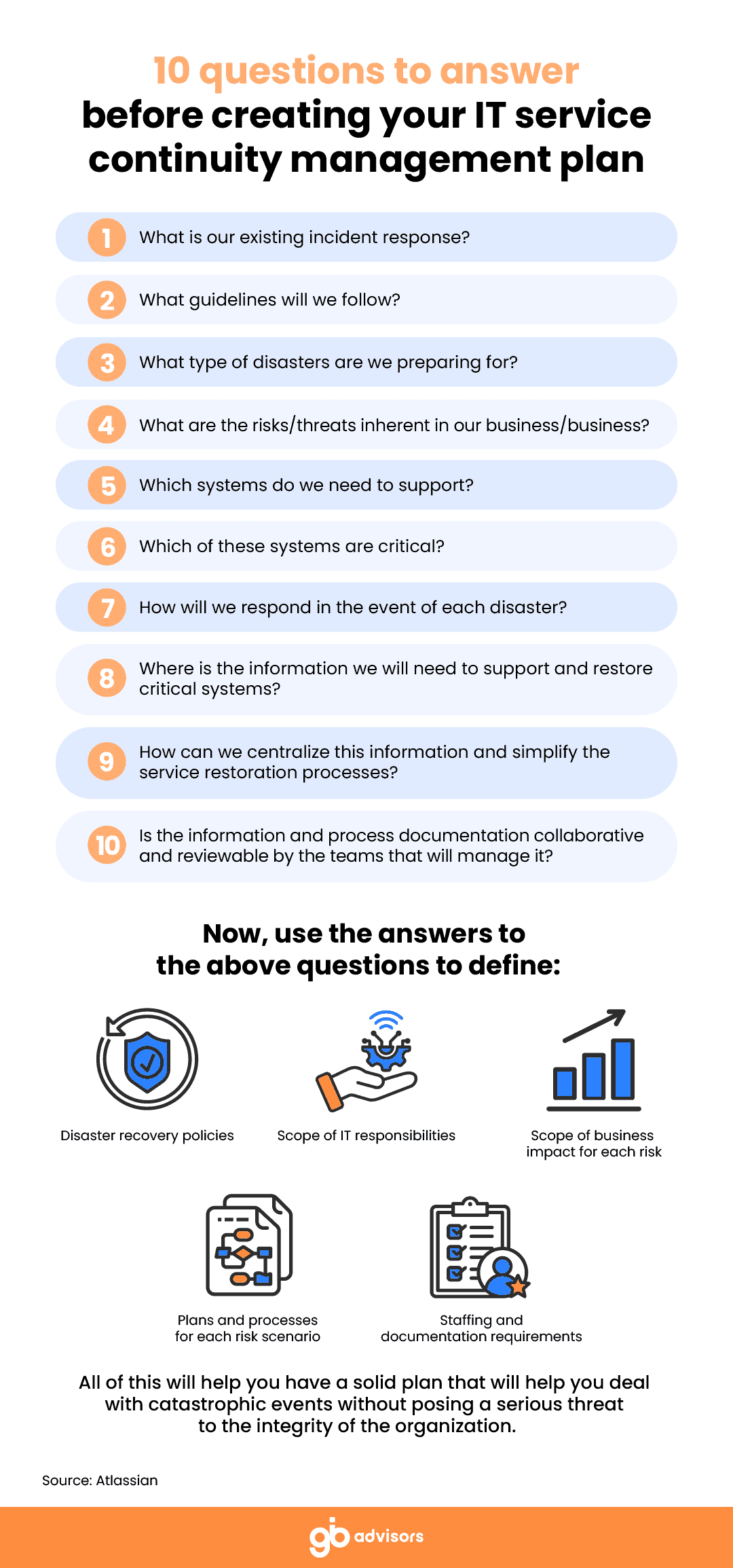Is IT Service Continuity Management Important to Your Organization?
The relevance of IT service continuity management lies in its relationship with business continuity. In this sense, business continuity depends, to a certain extent, on the continuity of IT services within the organization.
This connection is because IT service continuity management is responsible for the anticipation and response to events that threaten business continuity, looking to diminish its impact on the organization.
In this blog entry, you’ll know more about the five stages of IT service continuity management.
In addition, we show you how you can make this management effective with software.
Who is Responsible for IT Service Continuity Management?
- Service Continuity Manager
- Service Continuity Recovery Team
5 Stages of IT Service Continuity Management
Planning
How does the planning process begin in IT service continuity management?
This process starts by assessing the organization’s incident response.
In this assessment, you will try to discover if the organization already has guidelines documented or the type of risks linked to the organization.
With this, we seek to lay the foundations that will allow us to create and establish concise documentation of processes that need to be repeatable.
Only in this way can this assessment and subsequent plan become the standard for responding to and managing potential catastrophic scenarios. 
Attribution of responsibilities
Attribution of responsibilities is the second step in IT service continuity management.
Within the roles part of this management, determining who will be responsible for disaster management or who will be in charge of maintaining and updating all related documentation is vital.
Determining clear and well-documented roles and responsibilities within the management will provide the stability that benefits the monitoring of the established processes.
It also helps to evaluate, improve and update these processes and their documentation.
Communication
No matter what organizational aspect we are talking about, if it does not involve good communication, the performance of that aspect is likely to be poor.
The lack of efficiency resulting from poor communication can be economically and even entrepreneurially detrimental to the organization in the long term.
We must also bear in mind that IT service continuity management is of vital importance for business continuity.
In this respect, communication takes on an extra layer of importance. Without broad visibility of continuity management and clear communication channels with stakeholders, a fast response will not be easy to meet in threat scenarios.
So, not only does communication keep stakeholders on board and helps senior management avoid panic during a disaster-level incident.
It also allows the team to request help from other teams to mitigate the risk of friction caused by organizational confusion.
Testing

In the third stage of IT service continuity management, we have the testing of the plan in place.
How else can you measure the effectiveness of the plan created if not by testing it to evaluate its effectiveness?
In this stage, you will have to carry out drills to assess your continuity management plan.
This assessment will allow you to identify potential weaknesses. It will also help you prepare for unforeseen events and possible points for improvement.
All this will allow you to adjust the plan to new requirements.
In this phase, you will have the chance to assess the preparation of the teams involved in the ITSCM plan execution.
Moreover, you will also have to assess all the documentation on the plan. Ultimately, this represents the first initiative of continuous improvement and evolution of this management.
Evaluation and continuous improvement
Although this seems to be the end of the ITSCM process, it is the beginning of a constant iteration moving the whole management forward.
As a result of this iteration, the ITSCM management can adapt to the changing nature of potential threats.
It will also facilitate the response to unforeseen events. As a result, the organization will acquire a more robust nature when facing disaster scenarios.
How can your organization achieve this? Only with good communication among stakeholders and accessible documentation in a way that facilitates its evaluation and constant updating.
Without this, it would be harder to comply with the plan. This will increase the impact of any disaster scenario, economically and business-wise.
How does ITOM software help you manage IT service continuity?
ITOM software can help you manage your organization’s IT operations. In addition, it also helps your business continuity to protect its integrity and continuity of your business.
With this type of software, you will be able to:
- Manage knowledge bases with all the necessary documentation on ITSCM planning.
- Fully visualize all ITSCM management, the roles involved, and their responsibilities.
- Integrate communication and collaboration tools to accelerate response to catastrophic scenarios.
- Extensively monitor continuity management and all its processes to ensure continuous improvement.
This means that you will be able to centralize the management of both IT operations and ITSCM. This will provide efficiency, visibility, and control to improve the effectiveness of any response to threat scenarios.
Contact us today if you would like more information on how we can help you establish robust IT service continuity management and ensure business continuity with software.



